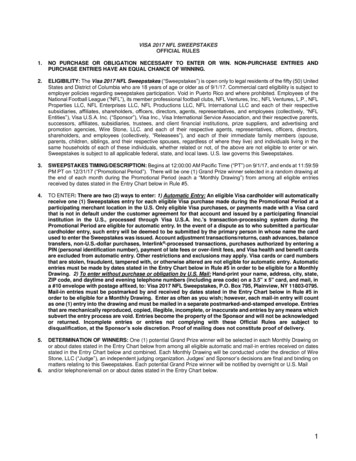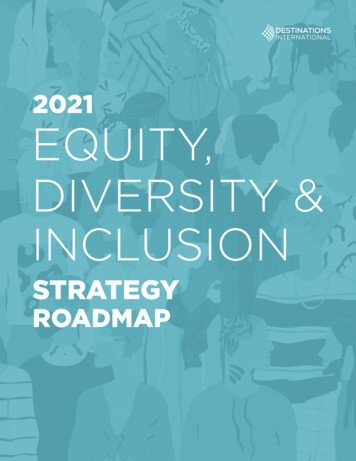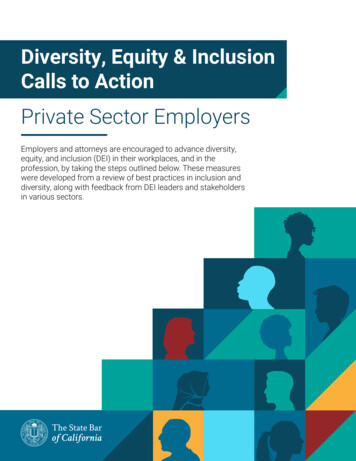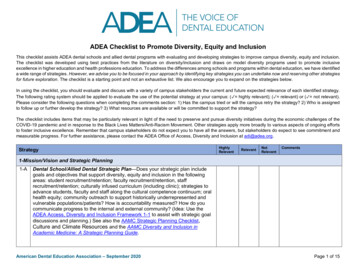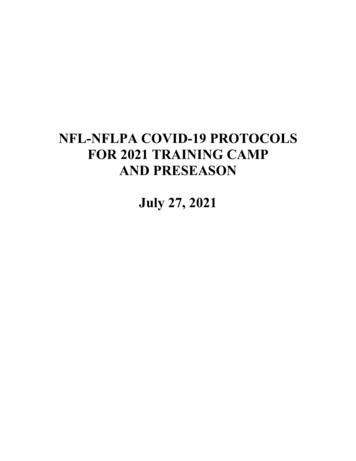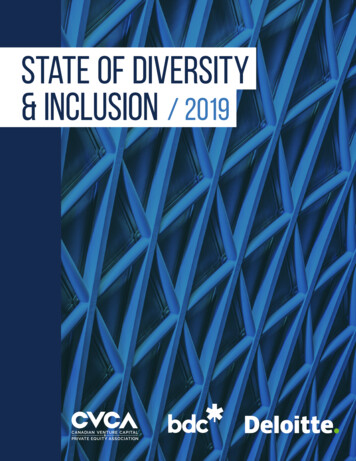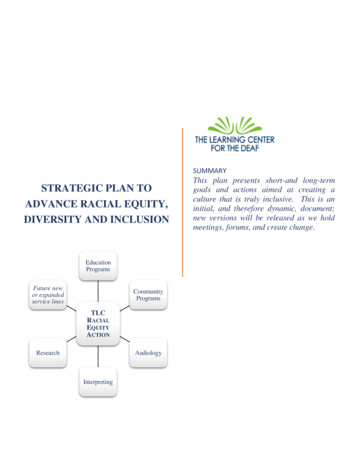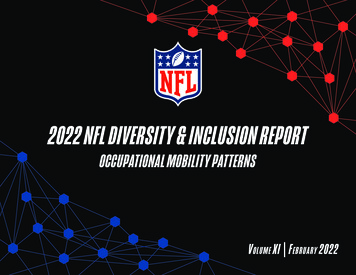
Transcription
2022 NFL DIVERSITY & INCLUSION REPORTOCCUPATIONAL MOBILITY PATTERNSVolume XI F ebruary 2022
OCCUPATIONAL MOBILITY PATTERNSV o l u m e XI F e b r u ary 2022IN THE NATIONAL FOOTBALL LEAGUEPRINCIPAL INVESTIGATOR AND LEAD RESEARCHERD r . C. K eith H arrisonPROFESSOR & ASSOCIATE CHAIR / CHIEF ACADEMIC OFFICERCOLLEGE OF BUSINESSSPORT BUSINESS MANAGEMENT PROGRAMUNIVERSITY OF CENTRAL FLORIDARESEARCHER AND REPORT CO-AUTHORS cot t B u kst e inASSOCIATE INSTRUCTOR & DIRECTOR OF UNDERGRADUATE PROGRAMCOLLEGE OF BUSINESSSPORT BUSINESS MANAGEMENT PROGRAMUNIVERSITY OF CENTRAL FLORIDAA REPORT PRESENTED BY THE NATIONAL FOOTBALL LEAGUERESEARCH TEAM ACKNOWLEDGMENT: MICHAEL ONUCHOVSKY, SEAN GREENER, ANDRZEJ KARWACZYNSKI1This report is available online at https://operations.nfl.com and also at http://www.coachingmobilityreport.com
TABLE OFOFCONTENTSTABLECONTENTS3S tatemen t f r o m D r . C. K e i t h H a r ris o n4S tatemen t f r o m T r oy V i n ce n t5R eport B ackg r o u nd6R esearch M e t h od o l o gy7-22R esearch F i n din g s a nd R e su lts23-32D ata A na lysis a nd I n sig h ts33-34P ract ic a l P r o p os a ls a nd S t r at e gic R e co m m e nd ati o ns32
STATEMENT FROM DR. C. KEITH HARRISONProfessors Leslie Houts Picca and Joe R. Feagin (2007) set the tone for this year’s statement with this excerpt from their book Two-faced Racism: Whites in the Backstage andFrontstage: “The problem of ‘race’ in the contemporary world is substantially a problem of the white mind. In the United States case, at least two major interpretive frames havelong contended in the white mind in regard to racial matters. A centuries-old equality-and-justice frame envisages a society in which equality and justice prevail. Yet, there isalso a dominant white racial frame that has long motivated, sustained, and rationalized large-scale racial inequality and injustice” (p. vii). Often theory in the Ivory Tower (highereducation) does not link up with practice. In this statement, my goal is to briefly synthesize how theories of racial discrimination are in alignment with the hiring practices of NFLteams with men of color and specifically African American males that are continually passed over for head coaching and other team leadership positions that they should have theopportunity to fail at just as much as succeed in the leadership position.I am in no way saying that every team owner is racist against non-Whites when making the final decision to hire a head coach, coordinator or general manager in the NFL. So then,what am I saying based on the aforementioned quote? Two concepts from the scholars’ narrative above are pertinent to the state of mobility hiring patterns in the NFL: backstage andfrontstage racism. What does this mean in basic terms?Frontstage racism exists when whites reveal how they, their acquaintances, and their relatives perceive racial performances differently in spaces or places with diverse andmultiracial populations as compared with their racial performances in spaces or places where they are only with those who appear to be White (which is termed backstage). Thebackstage setting and social context is typically a private and comfortable place for Whites (Picca & Feagin, 2007). There are practical examples and application to the current NFLhead coach, general manager and coordinator hiring situation. Racial performances with the Rooney Rule and interviews in general have seen a serious falloff in terms of the lackof non-White coaches getting hired over the last half decade or more. The concept of frontstage and backstage is at play ranging from what are perceived to be “sham interviews” toJon Gruden’s private emails that were revealed in 2021 with anti-inclusionary tones, lack of human respect and proactive discriminatory content with pointed hatred for variousgroups outside those in power positions.This theme leads to the following conclusion for the 2022 mobility report: we can only get those in charge making the final decisions to see with different eyes if they only have alteredhearts and gut feelings about what is perceived to be different from them in a way that impacts their comfort level. This includes the hiring process during interviews, meetings,meals and the cultural machine of life’s interactions. The diverse candidate pool has exponentially expanded in recent years—it is now time for many team owners to expand theirthinking and overall approach when it comes to making key football staff hiring decisions in order to ensure an equitable process and produce optimal results.Stay tuned sports and football world—as Dr. Harry Edwards states: “There are no final victories.”3
STATEMENT FROM TROY VINCENTThrough the last decade of Diversity & Inclusion Mobility Reports, Dr. Harrison and his team have identified many areas for improvement and have tracked the NFL’s progress inaddressing deficits in minority mobility, and diverse and inclusive hiring practices. In response, the NFL has incrementally improved development of the pipeline, preparation ofcandidates, data collection, the interview process, and even incentives –everything possible to provide a level playing field, an equal opportunity, for people of color to access thehiring process on fair and equitable terms.The very intentional policy modifications over the past two hiring cycles are having a positive result in breaking down barriers for primary and secondary football positions. Eachyear, policy changes are implemented, including Rooney Rule expansions, anti-tampering and specific job descriptions, data analysis, enhanced reporting and unbiased scientificstatistical measuring. Yet, with all these efforts and more adjustments forthcoming, progress is rarely achieved at the head coaching position.The NFL is committed to attaining a diverse and inclusive workforce of coaches and front office personnel. But the one missing component to reaching this goal is the ability tochange the hearts of those who are in charge of hiring. In an effort to explain what we are dealing with, terms are often applied: backstage and frontstage racism, unconscious bias,prejudice, etc. These are in no way intended to offend the hiring decisionmakers, but rather to identify and lend context to what people of color and other minorities face during thehiring process. These descriptions are very real to those who are experiencing them even if those who are practicing them are unaware.We, however, remain painfully aware of the work ahead. We must strive to create a workplace culture that doesn’t require mandates to interview people of color and minorities, aculture guided by doing the right thing for the right reasons, not because of a policy. We must normalize fairness, inclusivity and opportunity as an extension and reflection of thegame as it relates to everyone who ever played and to the diversity of fans throughout the world.In 2003, the Rooney Rule was a necessary tool toward promoting fair and equitable hiring. In 2022, we are reimagining hiring practices. It is time to eliminate the double standard onhiring, retention, and rehiring. Long overdue is a level playing field on the solid ground of fairness where opportunity is not limited by who you don’t know or what you look like.Our efforts must be aimed at eliminating bias, promoting trust, developing skills and providing opportunity—essentially expanding the football meritocracy beyond those playing thegame to coaching and front office positions. It’s a culture change to reflect the true values of the game. It’s a heart change to align the words people speak with their actions.4
REPORT BACKGROUNDThis empirical research report series began analyzing data on occupational mobility patterns of key NFL team leaders commencing with the start of the 2012 NFL regular season in order to develop actionable data-driven policy and best practicesrecommendations at both the league and team levels. The current Volume XI report supplements and complements the comprehensive annual internal league-developed “NFL Coaching Demographics” report. A primary goal of this multifaceteddata-driven initiative is to provide real-time data combined with strategic recommendations to help produce measurable goals and improved results in future hiring cycles, especially concerning the persistence of disparate outcomes for leaders ofcolor with respect to NFL general manager, head coach, and offensive coordinator roles. This independent report also aims to function as a core resource that supports an overall strategic, thoughtful, ambitious, and program-based blueprint for scalableimprovements relating to career opportunities for coaches and other team leaders of color. Simply put, this Volume XI research report is a direct call to action to strengthen leaguewide processes, expand inclusive programming, shift the mindset of hiringmanagers, and increase accountability.The findings within this report highlight the need to transition traction into action by inviting all league and team stakeholders to renew a commitment to more equitable hiring processes and resultant more diverse and inclusive coach and front officestaffs. Data-driven policies, programs, and incentives can certainly create incremental progress/momentum and result in a meaningful paradigm and culture shift by facilitating heightened awareness and increased stakeholder engagement. However, agenuine commitment by all hiring managers to hire, develop, and promote leaders of color is absolutely critical to produce compelling, sustainable outcomes.The current study on occupational mobility patterns expands existing research within the diversity, equity, and inclusion space via an extensive analysis related to whether racial and ethnic minorities face occupational access barriers prior to as well asafter one or more stints as a head coach in the NFL. In addition, this research study examines occupational access barriers and mobility patterns with respect to NFL general managers, offensive coordinators, defensive coordinators and other primary NFLteam position coaches—for example, quarterbacks coach, wide receivers coach, tight ends coach, running backs coach, offensive line coach, linebackers coach, defensive line coach and defensive backs (secondary) coach.This pragmatic research study aims to address the following four research questions:1234Do coaches and other leaders of color within the NFL face actual (and perceived)access barriers with respect to occupational mobility patterns?What factors and variables impact and influence the occupational mobility patterns of coaches and other leaders ofcolor within the NFL (for example, previous coaching/leadership experience and network-based connections)?What are examples of innovative practical strategies with respect to improving career opportunities for coaches and other leadersof color within the NFL, as best practice models potentially shift from a “talent pipeline” focus to a “talent pathway” emphasis?Should current NFL players be more actively involved in the decision-making process for new head coach hires—and,correspondingly, should NFL team owners be less involved in the hiring process for new head coaches?The remainder of this research report shares data and then utilizes that data to support practical policy and hiring process related recommendations. Previous reports and policy reforms have produced gradual changes and noteworthy improvements.Nonetheless, deeper systemic overhauls and culture/mindset shifts continue to be vital to yield prolonged meaningful change in the hiring cycle results.5
RESEARCH METHODOLOGYThis research study analyzes data and attempts to decode media narratives regarding NFL head coach demographics, tenure/stint and occupational mobility patterns from the start of the 1963 NFL season to February 2022. This specific range of NFL seasonsis utilized because 1963 serves as the first season during which the NFL began to track relevant data on head coach mobility patterns.This research study also contains detailed data regarding NFL offensive coordinator, defensive coordinator, special teams coordinator and general manager demographics as well as overall tenure and mobility trends from the start of the 2012 NFL regularseason (September 5, 2012) to kickoff at Super Bowl LVI (February 13, 2022). This specific date range is utilized because this independent NFL Diversity & Inclusion Research Report Series began analyzing data on occupational mobility patterns commencingwith the start of the 2012 NFL regular season.The present research study also highlights mobility patterns of head coaches, offensive coordinators, defensive coordinators, special teams coordinators and general managers during the approximate one-year period from the day following Super Bowl LV(February 8, 2021) to kickoff at Super Bowl LVI (February 13, 2022) in order to provide a timely, precise snapshot of major mobility trends and themes.A comprehensive database of descriptive data was developed to evaluate the career paths, organizational tenure and occupational mobility patterns of current NFL position coaches in conjunction with examining opportunities for these position coachesto earn promotions to coordinator or head coach positions. In addition, this research study integrates descriptive data from recent interconnected research conducted by the NFL related to occupational mobility and job success determinants of NFL headcoaches and other primary football operations team leaders.Researchers verified the number of vacancies filled and scrutinized the individual separations, trajectories and occupational patterns of NFL head coaches, offensive coordinators, defensive coordinators, special teams coordinators and general managersbased in part on data provided by the NFL along with publicly available data on recent coach, coordinator, and general manager hires. This research study focuses specifically on an analysis of access, opportunity and coaching mobility (that is, the numberof individuals who have held head coach positions) instead of the total number of head coach vacancies from 1963 to February 2022—as a result, if an individual was a head coach for multiple NFL teams, this study counts that coach one time in the data set.This same precise analytical framework was also applied to the occupational mobility patterns of offensive coordinators, defensive coordinators, special teams coordinators and general managers from 1963 to February 2022. This research study alsospotlights additional key head coach “pipeline positions” such as quarterbacks coach, linebackers coach and defensive backs (secondary) coach.The next section of this research report presents the findings and results related to an extensive descriptive analysis on the occupational mobility patterns of more than 600 current and former NFL head coaches, general managers, offensive coordinators,defensive coordinators, special teams coordinators and position coaches."The process is broken. We have exhausted ourselves with programs and initiatives . . . We don’t have aresource issue. This is a willingness and heart issue. You can’t force people, so we have to continue toeducate and share with those in the hiring cycle."Troy Vincent, NFL Executive Vice President of Football Operations6
The NFL archival team human resource database contains demographic data on current and former NFL head coaches starting with the 1963 regular season. From the start of the 1963 NFL season through kickoff at Super Bowl LVI (February 13,2022), only 19 different African American men, four Latino American men, one Lebanese American individual, and one multiracial individual have served as head coaches in the NFL. As of February 2022, five head coaches of color led NFL teams ascompared with 27 White NFL head coaches—the same exact totals as compared with the previous NFL season.The findings of the current study indicate that, historically, NFL teams have been reluctant to hire a person of color for a head coach, offensive coordinator or defensive coordinator position after a person of color has previously served as a headcoach in the NFL. Since the start of the 1963 NFL season, 118 White individuals have been hired as an NFL head coach, offensive coordinator or defensive coordinator after a first NFL head coach opportunity, whereas only 21 men of color have beenhired as an NFL head coach, offensive coordinator or defensive coordinator after a first head coach opportunity. In addition, since the start of the 1963 NFL season, 27 White individuals have been hired as an NFL head coach, offensive coordinator ordefensive coordinator after a second NFL head coach opportunity, whereas only four men of color have been hired as an NFL head coach, offensive coordinator or defensive coordinator after a second head coach opportunity.Within this report, a specific emphasis is placed on the occupational mobility patterns of offensive coordinators and defensive coordinators because these two team coaching positions have historically functioned as the primary career pipelinesfor NFL head coach hires. For instance, findings in the current research study indicate that 37 of the 71 head coaches hired since the start of the 2012 NFL regular season were previously an offensive coordinator in the NFL for at least one full NFLseason before earning a head coach opportunity. Twenty-one of the 71 head coaches hired since the start of the 2012 NFL regular season were previously a defensive coordinator in the NFL for at least one full NFL season before earning a head coachopportunity.Between February 8, 2021 (day following Super Bowl LV) and February 13, 2022 (day of Super Bowl LVI), NFL teams hired a total of 47 head coaches, offensive coordinators, defensive coordinators, special teams coordinators and general managersfor open positions. White individuals were hired for 32 of these 47 available positions. Fifteen men of color were hired for these 47 recently filled positions (see Figure 1A). In other words, men of color were hired for approximately 32% of therecently filled head coach, offensive coordinator, defensive coordinator, special teams coordinator and general manager openings—a disappointing and somewhat concerning decrease from the 2020-2021 hiring cycle during which men of colorwere hired for 37% of the openings (19 out of 52 positions) yet nonetheless a noticeable increase from the 2019-2020 hiring cycle during which men of color were only hired for 19% of the openings (6 out of 32 positions). Figure 1B provides asnapshot of the three most recent annual hiring cycle results from February 2019 to February 2022 for head coaches, offensive coordinators, defensive coordinators, special teams coordinators and general managers.Between February 8, 2021 (day following Super Bowl LV) and February 13, 2022 (day of Super Bowl LVI), 13 of the 52 head coaches, offensive coordinators, defensive coordinators, special teams coordinators and general managers who were fired,resigned, promoted, retired or otherwise “mutually parted ways” with an NFL team were men of color. Stated differently, from February 2021 to February 2022, the total number of men of color serving as head coaches, offensive coordinators,defensive coordinators, special teams coordinators and general managers merely increased by two within the NFL—indicating a concerning decrease from the 2020-2021 hiring cycle during which the total number of men of color serving as headcoaches, offensive coordinators, defensive coordinators and general managers increased by 10, while closely mirroring the 2019-2020 hiring cycle during which the total number of men of color serving in these primary team leadership rolesincreased by only one coach of color.OVERVIEW OF RECENT GENERAL MANAGER, HEAD COACH AND COORDINATOR HIRES
FIGURE 1BTHREE-YEAR HIRING CYCLE SUMMARY SPOTLIGHT (2019-2022)8
TABLE 1HEAD COACH MOBILITY PATTERNS (2021-2022)Name of FormerHead CoachRace of FormerHead CoachChicago BearsMatt NagyWhiteDenver BroncosVic FangioHouston TexansTeamNext Opportunity for Former CoachWhiteNathaniel Hackett WhiteOffensive Coordinator, Green Bay PackersDavid CulleyAfrican AmericanLovie SmithAfricanAmericanAssociate Head Coach & Defensive Coordinator,Houston TexansJacksonvilleJaguarsLas Vegas RaidersUrban MeyerWhiteDoug PedersonWhiteHead Coach, Philadelphia Eagles (2020)Jon GrudenWhiteJosh McDanielsWhiteOffensive Coordinator, New England PatriotsMiami DolphinsBrian FloresAfro LatinoMike McDanielMultiracialOffensive Coordinator, San Francisco 49ersMinnesota VikingsMike ZimmerWhiteKevin O'ConnellWhiteOffensive Coordinator, Los Angeles RamsNew Orleans Saints Sean PaytonWhiteDennis AllenWhiteDefensive Coordinator, New Orleans SaintsNew York GiantsWhiteBrian DabollWhiteOffensive Coordinator, Buffalo BillsOffensive Assistant, New England PatriotsAs illustrated in Table 1, between February 8, 2021 (day following Super Bowl LV) andFebruary 13, 2022 (day of Super Bowl LVI), NFL teams hired seven White head coaches.During that same time period, NFL teams hired two head coaches of color (Lovie Smithand Mike McDaniel). Mike McDaniel is a first-time NFL head coach and Lovie Smith is nowserving as an NFL head coach for the third time after previously coaching the ChicagoBears (2004-2012) and Tampa Bay Buccaneers (2014-2015). In addition, between thestart of the 2012 NFL season (September 5, 2012) and Super Bowl LVI (February 13,2022), NFL teams hired 58 White head coaches—82% of total head coach hires. Duringthat same time period, NFL teams hired only 13 head coaches of color—18% of total headcoach hires (see Figure 2).9Previous Position of New Head CoachDefensive Coordinator, Indianapolis ColtsSenior Defensive Assistant & LinebackersCoach, Pittsburgh SteelersMatt EberflusRace of NewHead CoachWhiteJoe JudgeSenior Assistant & Quarterbacks Coach,Kansas City ChiefsName of NewHead Coach82% WHITEtotal head coach hires2012 - 2022total head coach hiresCOACHES OF COLOR18%
FIGURE 2HEAD COACHES HIRED BETWEEN 2012-2022FIGURE 32014HEAD COACHES OF COLOR HIRED SINCE 20122016201820202022Lovie SmithLovie SmithJim CaldwellTodd BowlesHue JacksonAnthony LynnVance JosephSteve WilksBrian FloresRon RiveraRobert SalehDavid CulleyM. McDanielNotably, only four of the head coaches of color hired since the start of the 2012 NFL season remain current NFL headcoaches as of February 22, 2022 (Lovie Smith, Mike McDaniel, Ron Rivera and Robert Saleh)—Mike Tomlin has servedas head coach of the Pittsburgh Steelers since 2007. David Culley served as head coach of the Houston Texans duringthe 2021 NFL season. Brian Flores served as head coach of the Miami Dolphins from 2019-2021. Anthony Lynn servedas head coach of the Los Angeles Chargers from 2017-2020. Jim Caldwell served as head coach of the Detroit Lionsfrom 2014-2017. Todd Bowles served as head coach of the New York Jets from 2015-2018. Hue Jackson served ashead coach of the Cleveland Browns from 2016-2018. Vance Joseph served as head coach of the Denver Broncos from2017-2018. Steve Wilks served as head coach of the Arizona Cardinals during the 2018 NFL season (see Figure 3).Nine current NFL head coaches have been hired since the day following Super Bowl LV (February 8, 2021). Five of thesenew head coaches are first-time NFL head coaches (Brian Daboll, Matt Eberflus, Nathaniel Hackett, Mike McDaniel andKevin O’Connell). Three of these recently named head coaches are second-time NFL head coaches (Dennis Allen, JoshMcDaniels and Doug Pederson). And Lovie Smith recently earned a third NFL head coaching opportunity. Twenty-twoof the 32 current head coaches are serving as first-time NFL head coaches, eight are serving as second-time NFL headcoaches, and two are working as NFL head coaches for the third time in their coaching careers (see Figure 4). All ninerecently hired head coaches have prior NFL experience as either an offensive coordinator (six recently hired coaches)or defensive coordinator (three recently hired coaches). None of the nine recently hired head coaches has any priorNFL level experience as a special teams coordinator.10
FIGURE 4CURRENT HEAD COACH TENURE/STINTS (2022)NFL HEAD COACHESHIRED SINCE 2012NFL OFFENSIVE COORDINATOR EXPERIENCENFL DEFENSIVE COORDINATOR EXPERIENCE11FIGURE 5NFL OPPORTUNITY AFTER FIRST HEAD COACH POSITION (1963-2022)As illustrated in Figure 5, after separating from a first head coach position, 11 different coaches of color (42% ofthe 26 NFL head coaches of color who transitioned from first-time NFL head coach opportunities) have earned asecond head coach opportunity in the NFL since the start of the 1963 season. After separating from a first headcoach position, 60 White individuals have received a second NFL head coach opportunity since the start of the 1963season. As also illustrated in Figure 5, since the start of the 1963 NFL season, after separating from a first headcoach position, 31 different White individuals have held NFL offensive coordinator positions, and 29 different Whiteindividuals have held NFL defensive coordinator positions. For instance, Ben McAdoo was recently named offensivecoordinator of the Carolina Panthers after previously serving as head coach of the New York Giants from 2016-2017.Similarly, Gus Bradley recently earned a third consecutive opportunity to serve as an NFL defensive coordinator(hired by the Indianapolis Colts) after previously working as head coach of the Jacksonville Jaguars from 2013-2016.Correspondingly, since the start of the 1963 NFL season, after separating from a first head coach position, fourformer NFL head coaches of color (Tom Fears, Jim Caldwell, Hue Jackson and Anthony Lynn) have held an NFL offensivecoordinator position, and six former NFL head coaches of color (Raheem Morris, Romeo Crennel, Leslie Frazier, ToddBowles, Vance Joseph and Steve Wilks) have been subsequently hired as NFL defensive coordinators. During the mostrecent 2022 hiring cycle, no former NFL head coaches of color were hired as offensive or defensive coordinators.
FIGURE 6NFL OPPORTUNITY AFTER SECOND HEAD COACH POSITION (1963-2022)As illustrated in Figure 6, after separating from a second NFL head coach position, only one coach of color, LovieSmith, has earned a third opportunity to serve as the head coach of an NFL team. Fifteen White coaches have receiveda third opportunity to be the head coach of an NFL team. In addition, two White coaches (Bill Parcells and MartySchottenheimer) earned a fourth opportunity to be the head coach of an NFL team. Conversely, not a single person ofcolor has earned a fourth opportunity to be the head coach of an NFL team.As also depicted in Figure 6, after separating from a second head coach position, seven White individuals havereceived the opportunity to serve as an NFL offensive coordinator (as compared with zero men of color). Figure 6also illustrates that, after separating from a second head coach position, five White individuals have received theopportunity to serve as an NFL defensive coordinator (as compared with three men of color). During the most recent2022 hiring cycle, Lovie Smith was the only coach of color that earned an NFL head coach or coordinator opportunityfollowing two prior stints as an NFL head coach.FIGURE 7NFL OPPORTUNITY AFTER FIRST HEAD COACH POSITION (2012-2022)As illustrated in Figure 7, between the beginning of the 2012 NFL regular season (September 5, 2012) andSuper Bowl LVI (February 13, 2022), 14 White individuals and four men of color received a second head coachopportunity after “separating” (that is, being fired or promoted, resigning, retiring or otherwise mutually partingways) from a first head coach position during this time period. Lovie Smith, John Fox, Mike Mularkey and Jon Grudenare the only four coaches who received a third NFL head coach opportunity during this same timeframe. Duringthis same time period between the beginning of the 2012 NFL regular season (September 5, 2012) and Super Bowl LVI(February 13, 2022), 12 White individuals and three African American individuals received an opportunity to be anNFL offensive coordinator after separating from a first head coach position. Also, during this same time period ofapproximately 10 years, six White individuals and five African American individuals received an opportunity to be anNFL defensive coordinator after separating from a first NFL head coach position.12
Only ten NFL teams have hired two or more African American, Latino American, Lebanese American and/or multiracial head coaches from 1963-2022 (excluding interim head coaches from the analysis). For example, in February 2022,Mike McDaniel became the second non-interim head coach of color hired by the Miami Dolphins (after the team parted ways with another head coach of color, Brian Flores). Likewise, in February 2022, Lovie Smith became the secondnon-interim head coach of color hired by the Houston Texans (after the team parted ways with another head coach of color, David Culley).Based in part on NFL internal research data, since the start of the 2008 NFL season, 27 different individuals have served as interim head coaches (that is, these individuals were head coaches for part of an NFL season). Nine of the 27interim head coaches have been men of color (with Romeo Crennel and Perry Fewell twice serving as interim NFL head coaches since 2008). Five of the nine interim NFL head coaches eventually earned a head coach opportunity witheither the same or a different NFL team. Mike Singletary, Leslie Frazier and Romeo Crennel represent the only three men of color who earned the head coach position with their same team after serving as interim head coach for partof the immediately prior season. Likewise, since the start of the 2008 NFL season, Anthony Lynn is the only coach of color to earn a head coach position with a different NFL team after serving as an interim head coach for part of theimmediately prior season. Relatedly, in Janu
as head coach of the Los Angeles Chargers from 2017-2020. Jim Caldwell served as head coach of the Detroit Lions from 2014-2017. Todd Bowles served as head coach of the New York Jets from 2015-2018. Hue Jackson served as head coach of the Cleveland Browns from 2016-2018. Vance Joseph served as head coach of the Denver Broncos from 2017-2018.
